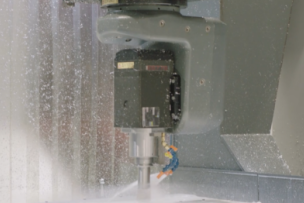ISCAR is the largest of the 15 companies comprising IMC (International Metalworking Companies). Together, they supply a dynamic comprehensive line of precision carbide metalworking tools. These companies produce a wide range of carbide inserts, carbide endmills, and cutting tools, covering most metal cutting applications. IMC also provides engineering and manufacturing solutions to major industries throughout the world. Many innovative products, designed especially for customer requirements, have made IMC a world leader in major manufacturing industries such as automotive, aerospace, and die & mold production.
In machining aerospace components, the main challenges relate to component materials. Titanium, high-temperature superalloys (HTSA), and creep-resisting steel are difficult to cut and machining is a real bottleneck in the whole aircraft supply chain. Poor machinability of these materials results in low cutting speeds, which significantly reduces productivity and shortens tool life. Both these factors are directly connected with cutting tools. In fact, when dealing with hard-to-machine typical aerospace materials, cutting tool functionality defines the existing level of productivity. The truth is, cutting tools in their development lag machine tools, and this development gap limits the capabilities of leading-edge machines in the manufacturing of aerospace components.
Modern aircraft, especially unmanned aerial vehicles (UAV), feature a considerably increased share of composite materials. Effective machining composites demand specific cutting tools, which is the focus of a technological leap in the aerospace industry.
Aircraft-grade aluminum continues to be a widely used material for fuselage elements. It may seem that machining aluminum is simple, however, selecting the right cutting tool is a necessary key to success in high-efficiency machining of aluminum.
A complex part shape is a specific feature of the turbine engine technology. Most geometrically complicated parts of aero engines work in highly corrosive environments and are made from hard-to-cut materials, such as titanium and HTSA, to ensure the required life cycle. A combination of complex shape, low material machinability, and high accuracy requirements are the main difficulties in producing these parts. Leading multi-axis machining centers enable various chip removal strategies to provide complex profiles in a more effective way. But a cutting tool, which comes into direct contact with a part, has a strong impact on the success of machining. Intensive tool wear affects surface accuracy, while an unpredictable tool breakage may lead to the discarding of a whole part.
Advanced multitasking machines, Swiss-type lathes, and live tooling lathes have profoundly changed manufacturing small-size parts of various hydraulic and pneumatic systems, actuators, and accessories, which are used in aircrafts. Consequently, the aerospace industry requires more and more cutting tools that are designed specifically for such machines to achieve maximum machining efficiency.
A cutting tool – the smallest element of a manufacturing system – turns into a key pillar for substantially improved performance. Therefore, aerospace part manufacturers and machine tool builders are waiting for innovative solutions for a new level of chip removal processes from their cutting tool producers. The solution targets are evident: more productivity and more tool life. Machining complex shapes of specific aerospace parts and large-sized fuselage components demand a predictable tool life period for reliable process planning and a well-timed replacement of worn tools or their exchangeable cutting components.
The cutting tool manufacturer has a limited choice of sources for finding an ideal solution and may only have cutting tool materials, a cutting geometry, and an intelligent robust design as the main instruments to progress. However, despite these limited choices, the cutting tool manufacturer continues all efforts to provide a new generation of tools to meet the growing requirements of the aerospace industry. COVID-19 has seriously slowed down industry development, but this does not make the industry demands any less actual. The latest tool designs are good evidence of the cutting tool manufacturer's response to the demand for aerospace component production.






Talk to Us!
Leave a reply
Your email address will not be published. Required fields are marked *